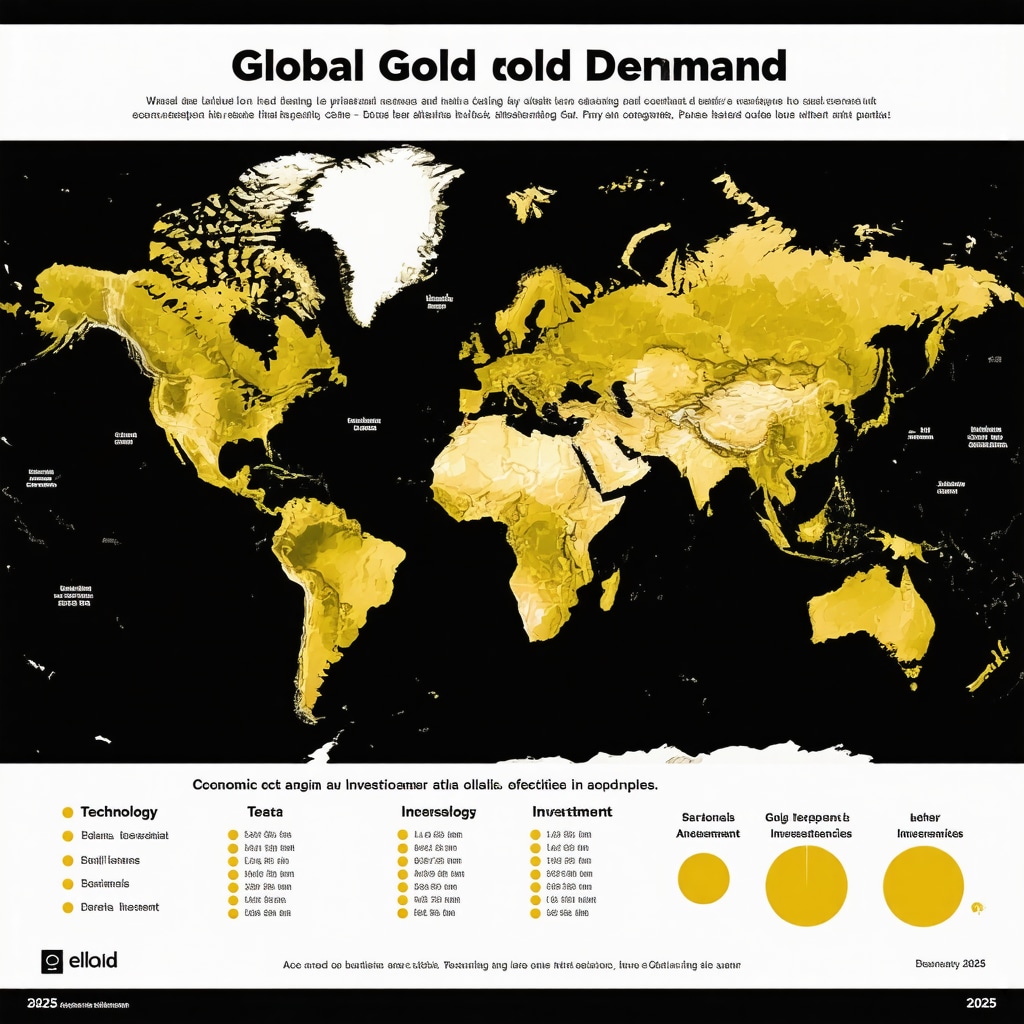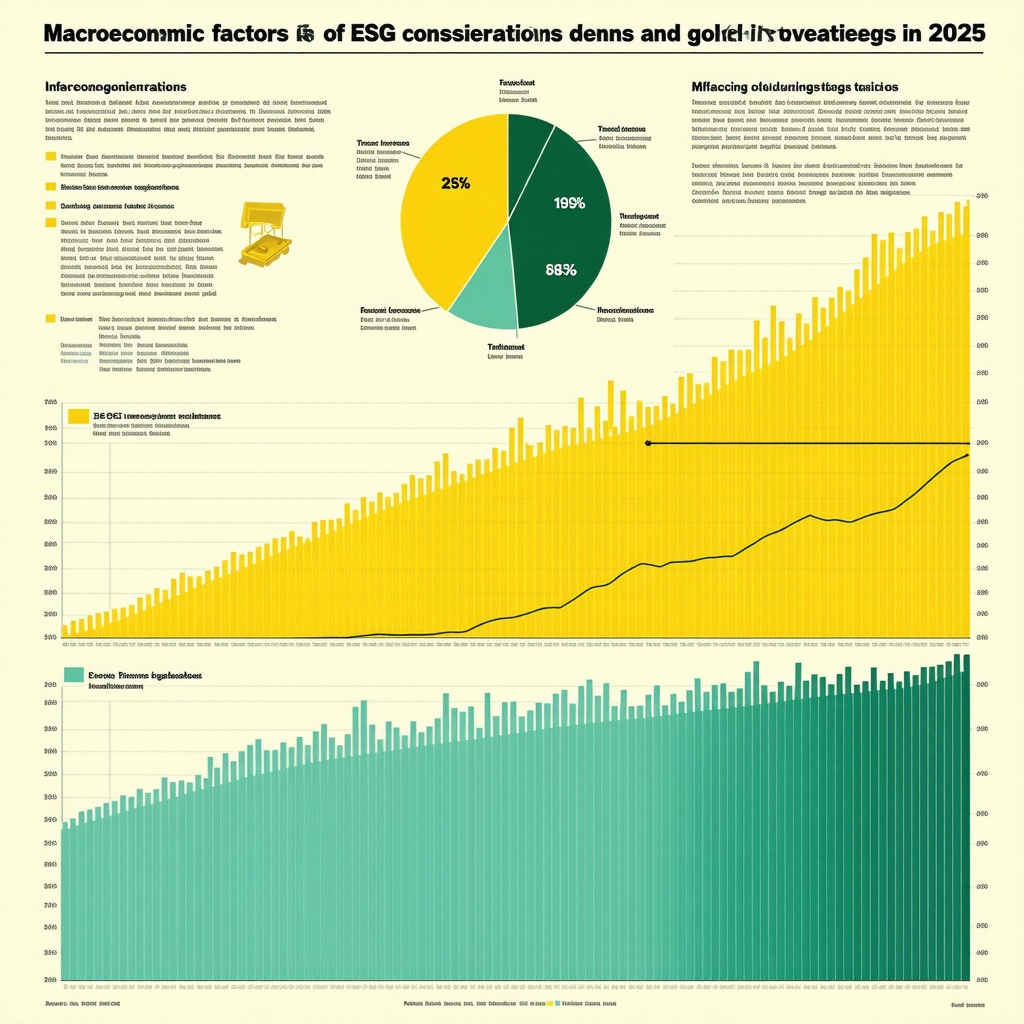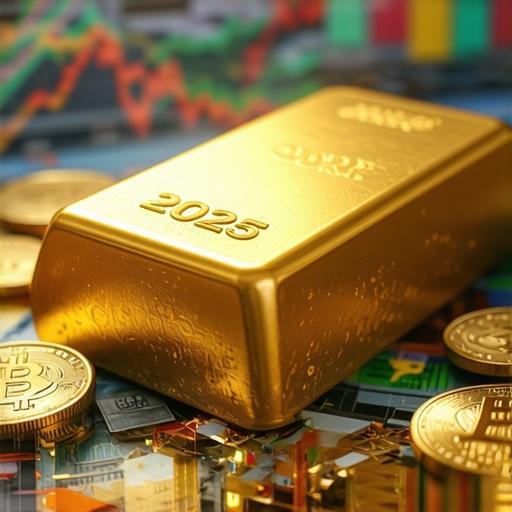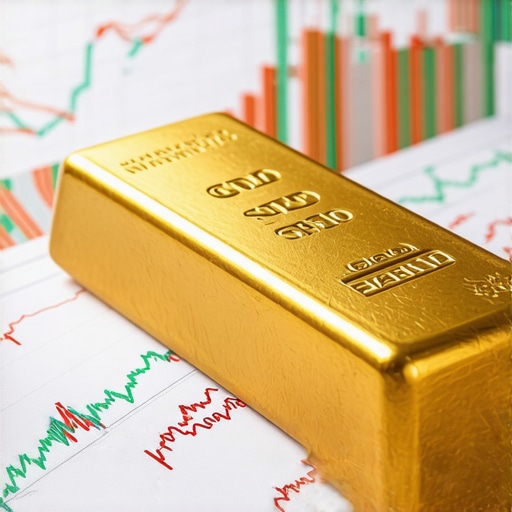Gold’s Glittering Tale: Why the World Can’t Get Enough
Imagine a shimmering thread weaving through history, economics, and culture—that’s gold. From ancient kings hoarding treasures to modern investors hedging against market chaos, gold demand has always been a fascinating story. But what’s driving the fever today? And why should savvy investors care beyond just the sparkle?
When Demand Dances with Dollars: The Market’s Golden Pulse
Global gold demand isn’t just about jewelry or shiny gadgets; it’s a complex dance influenced by central banks, technology, and even geopolitical jitters. Central banks, for example, have been quietly amassing gold reserves, signaling confidence or caution in equal measure. This subtle tug on the supply side can ripple across markets, nudging prices upward or downward in fascinating ways. Curious about how these massive purchases shape the gold landscape? You might enjoy a deep dive into central bank gold purchases and their global impact.
Is Gold’s Role as a Safe Haven Still Shiny Enough?
We often hear gold touted as the ultimate hedge against inflation and market volatility, but is this reputation still warranted in today’s shifting economic climate? The answer isn’t black and white. While gold often shines brightest during uncertainty, factors like evolving investor sentiment and emerging digital assets add layers of complexity. The World Gold Council’s recent report underscores how demand trends fluctuate with economic challenges, making this precious metal both a refuge and a rollercoaster ride (World Gold Council Gold Demand Trends).
From Coins to ETFs: Navigating the Gold Investment Maze
Not all gold investments glitter equally. Whether you’re eyeing physical gold bars, coins, or dipping toes into gold ETFs and mutual funds, each choice carries distinct market dynamics and risks. For those eager to secure wealth safely, exploring physical gold investment strategies can be enlightening. Meanwhile, ETFs offer liquidity and diversification, appealing to investors who prefer a more hands-off approach.
Why not share your thoughts? Have you noticed shifts in gold demand affecting your investment strategy? Join the conversation and leave a comment below to keep the golden dialogue flowing.
Unpacking the Nuances of Gold Demand Across Global Markets
Gold demand varies tremendously depending on geographic and economic contexts, with Asia, particularly China and India, traditionally dominating jewelry consumption. However, the landscape is evolving as technological applications and investment demand grow in prominence, reshaping market dynamics. Industrial uses in electronics and emerging sectors like green technology also contribute to nuanced demand profiles. Investors must appreciate these subtleties to anticipate shifts effectively.
How Do Macro-Economic Indicators Shape Gold’s Future Demand?
Understanding gold’s relationship with macroeconomic indicators such as inflation rates, currency strength, and geopolitical stability is crucial. For instance, when fiat currencies weaken or inflation surges, gold often becomes the preferred store of value. Yet, the interplay is not always straightforward; sometimes, strong global growth can dampen gold’s allure as investors favor higher-yielding assets. This complexity requires continuous analysis and agile strategy adaptation.
For a comprehensive exploration of how gold’s supply-demand balance influences its price movements, consider reading Understanding Gold Demand Trends Amid Global Changes. The article delves into pivotal market drivers, offering investors a well-rounded perspective.
Advanced Strategies: Leveraging Gold ETFs and Mutual Funds Amid Market Fluctuations
Gold ETFs and mutual funds present sophisticated avenues for investors seeking exposure without the challenges of physical storage or liquidity constraints. These instruments offer diversification within portfolios and can be tailored to different risk tolerances and investment horizons. However, understanding fee structures, underlying assets, and market conditions is imperative to optimize returns.
Investors should also consider the evolving landscape of gold mining stocks, which can offer leveraged exposure but come with unique operational and geopolitical risks. Exploring top gold mining stocks for long-term gains can complement a well-balanced gold investment strategy, enhancing portfolio resilience.
Engage with Us: What Strategies Have You Found Effective in Navigating Gold Market Volatility?
Your experiences and insights enrich the community’s understanding. Share your thoughts in the comments below or connect with fellow investors to cultivate a dynamic exchange of strategies and ideas.

Global Macroeconomic Variables: The Hidden Forces Steering Gold Demand
Delving deeper into gold’s complex demand landscape requires unraveling the subtle interplay of macroeconomic forces. Beyond the obvious inflation hedge narrative, gold’s allure is intricately tied to nuanced shifts in monetary policies, currency valuations, and international trade tensions. For example, when central banks alter interest rates, they indirectly affect the opportunity cost of holding gold, influencing investor appetite. Moreover, geopolitical flashpoints — from sanctions to regional conflicts — often trigger abrupt reallocations of portfolios, boosting gold’s safe-haven status.
However, it’s not merely the presence of economic turmoil that moves gold prices; it’s the expectation and timing of such events. Sophisticated investors monitor leading economic indicators like Purchasing Managers’ Indices (PMIs) and yield curve inversions to anticipate market sentiment swings, which often precede gold price volatility. This forward-looking analysis underpins why gold demand can surge even in seemingly stable economic periods.
How Do Interest Rate Expectations Influence Gold Demand in a Low-Rate Environment?
Interest rates represent one of gold’s most significant opportunity costs. In environments where real interest rates (adjusted for inflation) are negative or near zero, gold becomes particularly attractive as it does not yield interest but preserves purchasing power. Conversely, rising rates can diminish gold’s appeal, as fixed-income assets offer better returns. Yet, the relationship is not linear. Expectations of future rate hikes can cause preemptive shifts in gold demand, sometimes decoupling prices from current rate realities.
According to the International Monetary Fund’s detailed analysis on monetary policy and gold demand (IMF Working Paper on Monetary Policy and Gold Demand), investors’ anticipations about inflation trajectories and interest rate moves wield profound influence over gold market dynamics, underscoring the importance of macroeconomic literacy for investors.
Decoding Gold ETFs and Mutual Funds: Advanced Considerations for Portfolio Architects
While ETFs and mutual funds democratize access to gold, seasoned investors recognize that these instruments encapsulate complex risk-return profiles beyond physical gold ownership. Notably, the structure of gold ETFs—whether backed by allocated physical gold or synthetic derivatives—impacts liquidity, tracking error, and counterparty risk.
Furthermore, expense ratios and management fees can erode returns over time, particularly in volatile markets where gold prices stagnate or decline. Understanding the nuances of each fund’s strategy—such as whether it holds bullion directly, invests in futures contracts, or includes gold mining equities—is critical for aligning investments with risk tolerance and goals.
Another layer to consider is tax treatment, which varies across jurisdictions and can influence net returns. For instance, certain gold ETFs may be treated as collectibles for tax purposes, potentially incurring higher capital gains rates. Investors should consult tax professionals to optimize their strategies accordingly.
The Rising Trend of Actively Managed Gold Funds: Are They Worth the Premium?
Active management in gold funds aims to capitalize on market inefficiencies, sector rotations, or macroeconomic predictions. While these funds offer potential for outsized gains, they also entail higher fees and increased model risk. Evaluating the track record, management team expertise, and alignment with investor objectives is paramount before committing capital.
Strategic Integration: Using Gold to Fortify Complex Investment Portfolios
Integrating gold effectively entails more than simply allocating a fixed percentage; it involves dynamic portfolio construction techniques that consider correlations, volatility, and liquidity. Modern portfolio theory advocates for gold’s role as a diversification tool, given its historically low correlation with equities and bonds. However, this relationship can shift during periods of market stress or recovery phases.
Advanced strategies include using gold derivatives for hedging currency exposure, employing options to manage downside risk, or tactically adjusting gold weightings based on macroeconomic signals. Investors leveraging algorithmic trading models incorporate gold price momentum and volatility metrics to optimize entry and exit points.
In addition, gold’s interaction with emerging asset classes, including cryptocurrencies, invites novel portfolio approaches that balance traditional and digital safe havens. Understanding these multidimensional dynamics requires continuous education and adaptability in investment philosophy.
Are you leveraging these advanced gold investment insights in your portfolio? Explore our detailed guides and expert analyses to elevate your strategy and harness gold’s full potential.
Gold’s Role in the Age of Rising Global Debt and Currency Volatility
As governments worldwide grapple with ballooning debt levels and fluctuating currency valuations, gold’s timeless appeal as a monetary anchor gains renewed significance. The escalating global debt-to-GDP ratios and persistent currency devaluations have intensified investor focus on tangible assets that can withstand fiscal uncertainty. Gold, unlike fiat currencies, is impervious to direct policy-induced inflationary pressures, making it a critical hedge in an era of unconventional monetary policies.
However, the increasing complexity of financial instruments and the advent of digital currencies challenge traditional gold demand paradigms. Investors must therefore adopt a nuanced perspective, integrating macroeconomic signals with asset-specific fundamentals to optimize gold allocations. For those seeking a comprehensive exploration of gold’s supply-demand interplay and its implications, Understanding Gold Demand Trends Amid Global Changes offers invaluable insights.
How Can Investors Strategically Position Gold in Portfolios Facing Inflation and Currency Devaluation Risks?
Strategic positioning of gold demands a sophisticated understanding of inflation dynamics and currency risk. In environments where inflation expectations surge alongside weakening domestic currencies, gold’s value proposition as a store of wealth strengthens. Allocating gold through diversified instruments—ranging from physical bullion to ETFs and mining equities—enables investors to capture varying risk-return profiles while maintaining liquidity and operational flexibility.
Moreover, dynamic rebalancing aligned with real-time macroeconomic indicators, such as consumer price indices and currency exchange rate trends, can enhance portfolio resilience. The Bank for International Settlements Working Paper on Gold and Inflation underlines the importance of timing and instrument selection for maximizing gold’s protective qualities in volatile markets.
Integrating Sustainable and Technological Trends into Gold Investment Strategies
The rising emphasis on sustainable investing and technological innovation has begun to reshape gold market dynamics. The proliferation of green technologies, such as electric vehicles and renewable energy infrastructure, drives demand for gold in high-precision electronics, augmenting its industrial appeal. Consequently, investors might consider thematic strategies that harness both gold’s traditional safe-haven status and its growing role in cutting-edge industries.
In addition, the environmental and social governance (ESG) criteria increasingly shape gold mining operations and fund selections. Active investors prioritize funds and equities with transparent sustainability practices to mitigate reputational and regulatory risks. Understanding these evolving factors is essential for advanced portfolio architects seeking to future-proof gold exposure.
What Are the Implications of ESG and Technological Demand on Gold’s Long-Term Investment Thesis?
ESG integration and technological demand reinforce gold’s multifaceted value proposition. Sustainable mining practices and innovation-driven consumption can reduce supply-side uncertainties and stimulate steady demand growth. Investors should evaluate ESG scores and technological sector linkages alongside traditional market indicators to refine investment decisions.
For a deeper dive into gold investment options that balance traditional hedging with modern sustainability concerns, explore Gold ETFs and Mutual Funds: Best Choices for Stable Income. This resource highlights funds excelling in ESG compliance and industry exposure, suitable for sophisticated portfolios.
We invite you to share your strategies and perspectives on integrating macroeconomic insights and sustainability trends into your gold investments. Join the conversation by leaving a comment below and connecting with fellow experts to enrich this dynamic discourse.

Expert Insights & Advanced Considerations
Gold’s Role as a Dynamic Hedge Amid Monetary Policy Fluctuations
Gold’s traditional safe-haven status remains valid, yet its demand is increasingly sensitive to nuanced shifts in global monetary policies. Investors should monitor central bank actions—not only purchases but also interest rate changes and quantitative easing programs—as these influence gold’s opportunity cost and market momentum. Strategic timing aligned with policy shifts can optimize gold’s portfolio contribution.
Integration of ESG and Technological Drivers into Gold Investment Strategies
The evolving landscape where sustainability intersects with technological innovation reshapes gold demand profiles. Investors attuned to ESG-compliant mining operations and the industrial use of gold in green technologies can capture emerging growth vectors while mitigating reputational risks. This dual lens fosters a more resilient and forward-looking gold investment thesis.
Complexities of Gold ETFs and Mutual Funds Require Diligent Due Diligence
While gold ETFs and mutual funds democratize access, their diverse structures necessitate sophisticated analysis. Understanding variations in backing assets, fee structures, tax implications, and liquidity profiles is essential. Active management funds provide opportunities but demand scrutiny of performance consistency and fee justification. Seasoned investors tailor fund selections to align with nuanced risk-return targets.
Strategic Gold Allocation Demands Dynamic Portfolio Management
Effective gold integration transcends static allocation. Incorporating macroeconomic indicators, volatility measures, and correlation shifts allows tactical adjustments that enhance portfolio resilience. Utilizing derivatives and options can fine-tune exposure, hedge currency risk, and manage downside volatility, optimizing gold’s multi-dimensional benefits within complex portfolios.
Global Macroeconomic Variables as Predictors of Gold Demand Trends
Advanced investors harness leading economic indicators—such as yield curve dynamics, PMI data, and geopolitical risk assessments—to anticipate gold demand surges. This forward-looking approach distinguishes reactive from proactive strategies, enabling optimized positioning ahead of market inflections driven by inflation expectations or currency volatility.
Curated Expert Resources
World Gold Council – Gold Demand Trends: An indispensable source for comprehensive data and analysis on global gold consumption patterns, investment flows, and industrial demand, informing strategic decision-making (gold.org/goldhub/research/gold-demand-trends).
International Monetary Fund Working Paper on Monetary Policy and Gold Demand: Offers deep insights into how shifts in monetary policy and interest rate expectations impact gold markets, essential for macroeconomic contextualization (imf.org/publications).
Bank for International Settlements Research on Gold and Inflation: Explores timing and instrument selection strategies for optimizing gold’s inflation-hedging qualities, vital for tactical portfolio adjustments (bis.org/publ/work973.pdf).
Buying Gold Now – Understanding Gold Demand Trends Amid Global Changes: A cornerstone article offering nuanced perspectives on supply-demand interplay and market drivers tailored for serious investors (buyingoldnow.com/understanding-gold-demand-trends-amid-global-changes).
Buying Gold Now – Gold ETFs and Mutual Funds: Best Choices for Stable Income: Detailed guidance on selecting and managing gold fund investments with a focus on ESG compliance and performance metrics (buyingoldnow.com/gold-etfs-and-mutual-funds-best-choices-for-stable-income).
Final Expert Perspective
The intricate tapestry of gold demand in 2025 unfolds at the intersection of macroeconomic shifts, sustainability imperatives, and evolving investment vehicles. Far from a static asset, gold demands a sophisticated understanding of monetary policy nuances, ESG integration, and dynamic portfolio management techniques. Investors who cultivate this depth of insight position themselves to harness gold’s multifaceted roles—hedge, diversifier, and industrial commodity—with greater precision and confidence. For those ready to deepen their expertise, engaging with advanced resources and continuously refining strategies is the path to unlocking gold’s enduring potential. Share your most effective gold strategies or questions below, and explore our expert analyses to elevate your investment acumen further.










